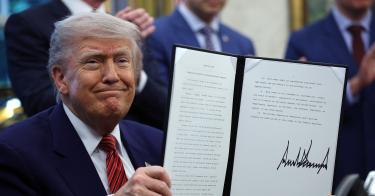Opponents of President Trump’s executive orders (EOs) to speed up the development of commercial nuclear technology claim they’re “could undermine” their intended goal. This is fearmongering, plain and simple. Trump’s EOs, in fact, could not only expand U.S. commercial nuclear energy but also easily revolutionize commercial nuclear power.
“Ordering the Reform of the Nuclear Regulatory Commission” could end up being the president’s most consequential executive order. A common grievance among those that support nuclear power is that the Nuclear Regulatory Commission (NRC) is too slow to grant approval to new permits and is a bottleneck to progress. The NRC’s supporters, however, insist that the low quality of permitting submissions makes the process more onerous, expensive, and time-consuming than necessary.
Trump’s EO moves beyond this by recognizing that decades of stacked regulations make any process conducted within the current system impossible to carry out efficiently. The order provides a means to overhaul the NRC process without undermining the integrity of the regulator.
In essence, Trump took a house that was built in 1975 (the year the commission was established) and ripped it down to the studs. The structure remains, but now it can be modernized.
>>> Our Energy Crisis Has a Nuclear Solution
To achieve this, the EO commands the NRC to “undertake a review and wholesale revision of its regulations and guidance documents,” sets a series of timelines to get matters done, and requires that the commission set deadlines for a series of common responsibilities, such as license approvals and power uprates.
As important as each of these are, while they may make the regulatory process more efficient, they likely wouldn’t do enough to change the underlying economics of nuclear power. However, in Section Five, part b, the executive order states, “Adopt science-based radiation limits.” This innocuous-sounding phrase could change everything—for the better.
That’s because the model that current regulations are based on for protection against low-dose radiation exposure doesn’t reflect the current scientific understanding regarding the actual risks. This forces nuclear power plant designers to engineer levels of protection into their plans that go well beyond the actual risks. Such protections are expensive and provide no additional benefit. The EO will bring regulatory standards into line with actual risks.
But we need to do more. The United States also needs to overhaul how it fuels its reactors and manages that fuel once it is used. The executive order “Reinvigorating the Nuclear Industrial Base” provides the process to handle both.
The U.S. commercial nuclear industry produces little of its own commercial nuclear fuel. This became a major problem when Russia invaded Ukraine in 2022 because U.S. nuclear companies got about a quarter of their nuclear fuel from Russia, and Russia was the only supplier of some fuel needed for certain advanced reactor designs.
Despite a ban on Russian uranium imports, Russian uranium is still fueling U.S. reactors. To reverse this, the order creates deadlines to develop plans to expand uranium fuel infrastructure and to access excess stockpiles of government nuclear fuel resources. Combined with regulatory relief, these plans would make a difference.
Producing fuel for reactors is only half the problem. That fuel needs to be managed and disposed of once it’s used. Solving that problem has befuddled American policymakers for years.
>>> Not Too Late for a Nuclear Revolution
Put simply, the 1982 Nuclear Waste Policy Act gave responsibility for managing and disposing of commercial nuclear waste to the federal government. The federal government has completely failed in its legal obligations and has not accepted a single atom of nuclear waste for disposal. This failure has nothing to do with the available technologies for managing and disposing of nuclear waste. It is a simple dereliction of duty by Congress and past administrations.
Trump’s EO provides an opportunity to finally change. It calls on the Secretary of Energy, in coordination with the heads of other critical agencies, to provide a plan for spent fuel management.
Critically, the EO does not assume that existing (and problematic) bureaucratic structures, roles and responsibilities, and legal frameworks will continue to define policy moving forward. Aside from the expected questions on technology and capabilities that any such review would entail, the EO demands answers to questions about budgets and laws.
This process lays the groundwork for realigning who is responsible for spent fuel management and how that process is to be financed. Given the abject failure of the current system, this is exactly what is needed.
Reforms on the margins of nuclear energy policy and regulation juiced by subsidies will not achieve the president’s stated goal of substantially increasing commercial nuclear energy in the United States. Doing so will require a policy revolution. That is the goal of President Trump’s executive orders.
This piece originally appeared in The National Interest https://nationalinterest.org/blog/trumps-executive-orders-are-the-first-steps-in-a-nuclear-revolution




